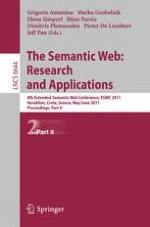The books (LNCS 6643 and 6644) constitute the refereed proceedings of the 8th European Semantic Web Conference, ESWC 2011, held in Heraklion, Crete, Greece, in May/June 2011. The 57 revised full papers of the research track presented together with 7 PhD symposium papers and 14 demo papers were carefully reviewed and selected from 291 submissions. The papers are organized in topical sections on digital libraries track; inductive and probabilistic approaches track; linked open data track; mobile web track; natural language processing track; ontologies track; and reasoning track (part I); semantic data management track; semantic web in use track; sensor web track; software, services, processes and cloud computing track; social web and web science track; demo track, PhD symposium (part II).
